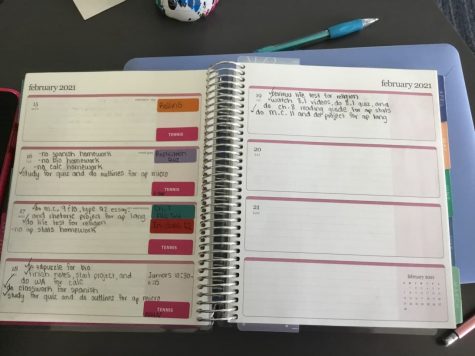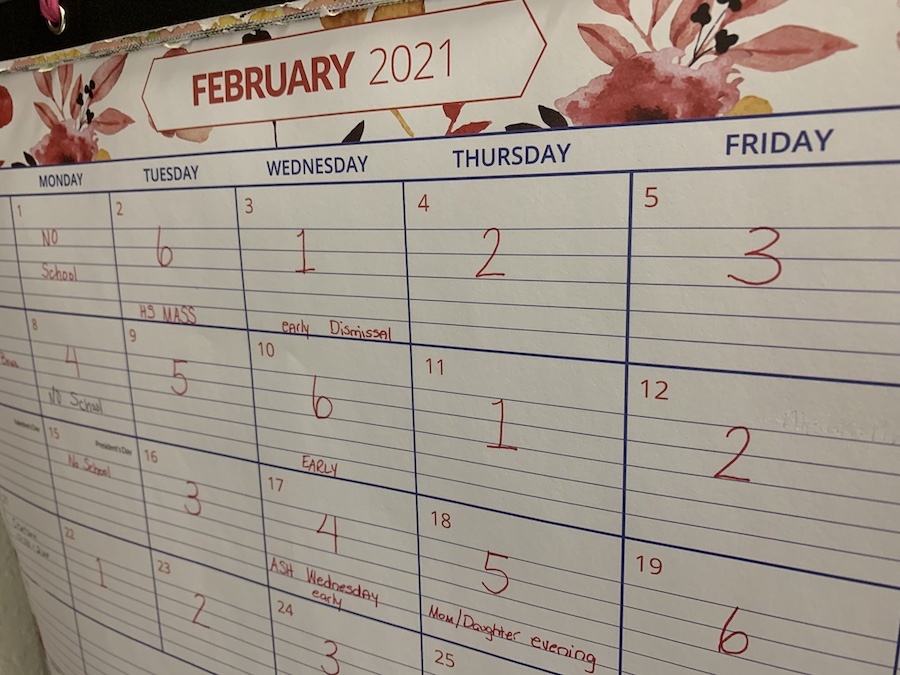How Should Students Organize Tasks?
February 24, 2021
A shocking 41% of to-do tasks are never completed. There are various reasons people do not finish them, such as having too many tasks, giving themselves too much time to complete the tasks, changing conditions, and making unrealistic to-do lists.
Many people may view to-do lists negatively if they have difficulty prioritizing the tasks. If lists are left incomplete, feelings of stress may occur. According to the Zeigarnik effect, interrupted actions are more likely to be recalled than tasks that have been completed. Constantly adding tasks can be overwhelming, as finding a place to start can be strenuous.
Despite the frustrations, our brains love to-do lists for many reasons. First off, they decrease anxiety about life’s chaos. Lists provide a plan to stick with and structure. They also serve as proof of achievements. Our brains receive a spike of dopamine from the satisfaction of checking off small completed goals. Dopamine makes it desirable to repeat this behavior.
The benefits of lists are organization and planning, making tasks easier to remember. Lists place tasks out of mind and onto paper, laying out the day in a concrete way. A sense of progress and accomplishment is a reward for making lists.
Individuals who make to-do lists are less likely to procrastinate. People who make written to-do lists procrastinate less than mental list makers or random, spur-of-the-moment lists. Lists can increase conscientiousness and decrease procrastination. Creating to-do lists often and consistently makes them a habit of the workflow.
“I organize my tasks with a paper planner. I have always been taught to prioritize tasks based on how soon they are due, but I have started to do things that are due later first. This helps me avoid procrastinating because I have to finish the rest of my work after I finish what is due in the further future first. I have to write everything down, or I forget. I have tried a lot of different methods, and my current ‘backward priority’ method definitely works best for me,” said Martina Bain (’23).
To make better lists, give earlier deadlines to begin working so tendencies of procrastination will be decreased. More specific action plans will increase motivation. Be realistic and ease yourself to choose tasks that maximize time and energy. It is essential to accept that interruptions are a part of life.
“Map out your week on Sunday and spread out your projects, homework, or studying over a period of three to four days for 30-45 minutes at a time; this includes studying or a test! Don’t try to do everything in one night. It’s not helpful for your brain or body to sit for an extended period of time. I’m also a huge fan of rewards or any nugget that will help you celebrate when you’ve met your goal. An example may be ‘if I finish this plan for today on time, then I’ll watch one to two of my favorite Netflix episodes.’ Also, add in some physical movement or activity before you begin with your to-do list. That may be the added energy boost you need to wake up your body after a long day of school, sports, and/or work,” said Learning Resource Specialist Dr. Julie Omodio-Griess.
For people who are scared to start larger tasks, try breaking it down into smaller pieces. For example, it is easier to “write the first chapter” than “write a book.” Starting small will provide a great starting point, and meeting these small goals will make you feel accomplished.
“First is to turn off all alerts and any temptations that will pull you away from your work. Give yourself a realistic chunk of time to work in one sitting. Prioritize your tasks and write down how long you plan to work on each assignment or item on your list. Stick to that timeframe and take a ten minute break after each segment but don’t be lured into your social media during this break, or you’ll never come back to your list. I love to cross off everything the moment it’s completed. It’s so rewarding to see my list shrinking by the minute. If anything goes unfinished and isn’t a priority, then I move that item to the top of my list for the next day,” said Griess.
Different methods will work in different ways, so not every person will feel the same way. The following are suggestions for various types of to-do lists that may work for you.
Calendars and Planners
One form of organization is a physical planner or a digital version. While it may seem daunting, calendars will keep individuals on task. Blocking off periods required for each task is suitable for work-life balance. This type of planning can be beneficial for listing other important events and dates, such as appointments, birthdays, and school schedules.
“Some electronic planners are excellent in that they mimic the written format by using the Apple Pen, but it eliminates the need to carry around a hard-bound planner. I do highly recommend, regardless of format, that the information is written versus typing because research does point out that physically writing the information helps to connect to the brain better than typing,” said Griess.

Written Lists
In general, written lists are better than digital ones since writing down tasks will make you more effective. While typing may be faster, it is better to write it down the old-fashioned way. Devices make it tempting to open other apps, which can be distracting. Typed notes are often written verbatim, and those who write longhand notes perform better on tests since they write the essential pieces of information.
It is important to have more organized, structured, and detailed lists. Simply writing words isn’t enough; a list needs to be clear and to the point, or the goals will not be prioritized.
One method is to keep a list as a reference, write one thing down on a post-it note, place it in your line of vision, and then hide the full list. People are more likely to follow through if they focus on one thing at a time.
Another method is to write three lists. One is for tasks that are planned to be finished today, so start with this one. Make another list for not time-sensitive tasks and schedule these for a later day. Finally, make a forever list of things.
The Ivy Lee method is a 100-year-old strategy where you write down only six things you need to complete the next day. Order them in importance, with one as your top priority and six as the least important. The next day, start the first task and do not stop until you finish. Do not try multitasking. Repeat the process for the other tasks. If a task is not completed, move them to your list for tomorrow. Make a new list of six tasks for the next day, and continue the cycle. This method is effective since you will wake up knowing exactly what to do and eliminates wasting time during the day. It forces you to make tough decisions and helps you be more productive when starting tasks.
Digital Lists and Apps
There are many organizational apps such as Todoist, the standard reminders app, and more. These lists can be color-coded by sections, and people can set recurring tasks. This method saves paper, and since people always carry their phones with them, it is easily accessible.

“I use the sticky notes app on my computer and just type out all my tasks on there. I think my way of organizing is efficient because it keeps me on task and helps me to keep track of my assignments well. I personally am not too picky with organizing, however, so it’s pretty simplistic,” said Sofia Girgenti (’23).
Students are always encouraged and welcome to visit Mrs. Kizer (last names A-L) or Dr. Omodio-Griess (last names M-Z) to help tweak your study or organization plan. Feel free to email them at [email protected] or [email protected] to set up a time to discuss.

